The Standard Liner Market is estimated to be valued at USD 12.5 billion in 2025 and is projected to reach USD 22.0 billion by 2035, registering a compound annual growth rate (CAGR) of 5.8% over the forecast period.
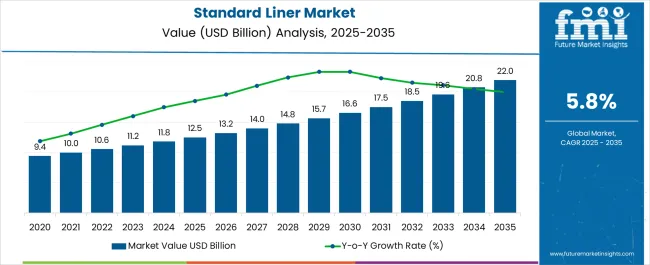
| Metric | Value |
|---|---|
| Standard Liner Market Estimated Value in (2025 E) | USD 12.5 billion |
| Standard Liner Market Forecast Value in (2035 F) | USD 22.0 billion |
| Forecast CAGR (2025 to 2035) | 5.8% |
The Standard Liner market is experiencing steady growth driven by the increasing demand for durable and efficient liner solutions across logistics, transportation, and storage applications. The future outlook for this market is shaped by the growing emphasis on product protection during transit, reduction of material wastage, and operational efficiency in supply chain management.
The rising adoption of standardized liner systems in warehouses, manufacturing units, and bulk storage facilities is supporting market expansion. Additionally, improvements in material technologies and production processes are enabling liners to provide enhanced resistance, flexibility, and load-bearing capacity.
Environmental and regulatory considerations are further influencing the choice of materials and designs, encouraging the use of versatile and recyclable liners As global trade volumes continue to increase and industries prioritize safe, cost-effective, and scalable packaging solutions, the Standard Liner market is anticipated to maintain robust growth in both developed and emerging regions.
The standard liner market is segmented by material type, product type, size, end use, and geographic regions. By material type, standard liner market is divided into Plastic and Metal. In terms of product type, standard liner market is classified into End Fill Bulk, Top Fill Bulk, Open Top Bulk, and Wide Access Bulk. Based on size, standard liner market is segmented into 40 Feet, 20 Feet, and 30 Feet. By end use, standard liner market is segmented into Chemical, Polymer Additives, Agrochemicals, Plastic Resin, Paints & Coating, Agriculture, Food & Beverages, Building & Construction, Pharmaceutical, Mining, and Others (Household, Personal Care, etc.). Regionally, the standard liner industry is classified into North America, Latin America, Western Europe, Eastern Europe, Balkan & Baltic Countries, Russia & Belarus, Central Asia, East Asia, South Asia & Pacific, and the Middle East & Africa.
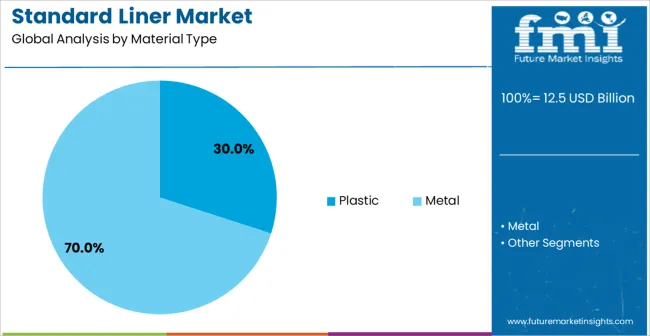
The plastic material type is projected to hold 30.00% of the Standard Liner market revenue share in 2025, establishing it as a leading material choice. This dominance is primarily driven by the high durability, lightweight characteristics, and cost-effectiveness of plastic liners.
Their chemical resistance and ability to withstand variable temperatures make them suitable for a wide range of storage and transportation scenarios. Furthermore, the ease of manufacturing and customization options for plastic liners allows for tailored solutions to meet specific operational requirements.
The segment has also benefited from growing awareness about minimizing product damage and optimizing supply chain efficiency, which has increased the adoption of plastic liners across multiple industries.
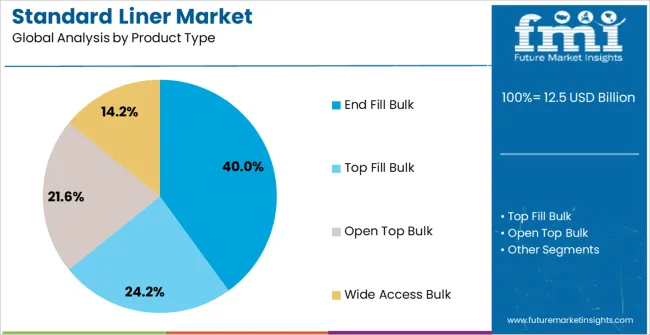
The End Fill Bulk product type is expected to capture 40.00% of the market revenue share in 2025, positioning it as the leading product type. This growth is driven by its ability to provide secure, space-efficient containment for large volumes of goods, reducing handling time and improving operational efficiency.
The design allows for easy filling and discharge, which enhances productivity in logistics and warehousing operations.
Increasing demand for bulk handling solutions and optimization of storage space has further reinforced the adoption of End Fill Bulk liners.
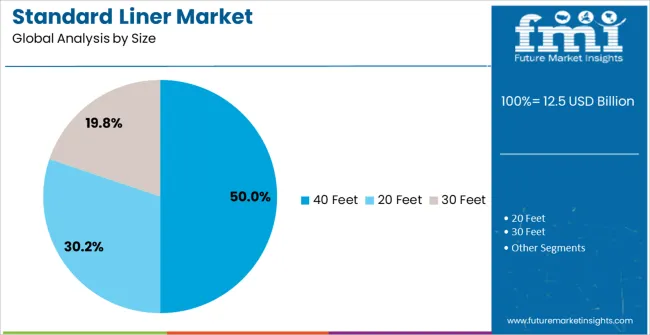
The 40 Feet size segment is anticipated to account for 50.00% of the Standard Liner market revenue in 2025, making it the dominant size choice. The preference for this size is influenced by the widespread use of standard 40-foot containers in global shipping and transportation networks.
This compatibility ensures seamless integration with existing logistics infrastructure, improving loading efficiency and reducing operational costs.
Additionally, the ability to accommodate larger volumes in a single liner enhances storage utilization, supporting the growth of this segment across commercial and industrial applications.
Standard liners are made of flexible low-weight plastics that can be separated easily when not in use. A standard liner is used as a protective layer over containers, which helps protect goods from dampness and moisture.
Furthermore, standard liners are cost-effective packaging solutions as compared to other formats. Standard liners also provide better protection for perishable items that need to be transported on time. Standard liners are recyclable, which is an additional factor that is expected to drive the market during the forecast period.
Standard liners are normally available in several materials, which include polyethylene, polypropylene and polyvinyl chloride. Moreover, metalized films made of aluminium, tin or steel are also available for standard liners.
In recent years, the logistics and shipping industry has witnessed significant growth. The standard liner market is thriving on the backdrop of the growing container shipping industry. In addition, the reliance of businesses on safety and uncontaminated compartment shipping is another factor boosting the usage of standard liners.
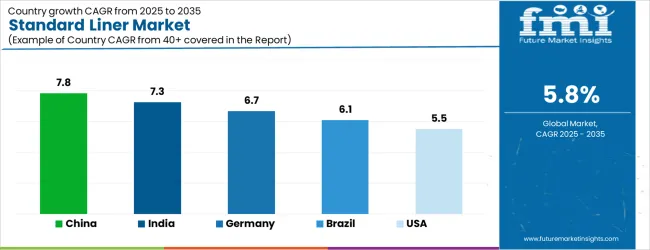
| Country | CAGR |
|---|---|
| China | 7.8% |
| India | 7.3% |
| Germany | 6.7% |
| Brazil | 6.1% |
| USA | 5.5% |
| UK | 4.9% |
| Japan | 4.4% |
The Standard Liner Market is expected to register a CAGR of 5.8% during the forecast period, exhibiting varied country level momentum. China leads with the highest CAGR of 7.8%, followed by India at 7.3%. Developed markets such as Germany, France, and the UK continue to expand steadily, while the USA is likely to grow at consistent rates. Japan posts the lowest CAGR at 4.4%, yet still underscores a broadly positive trajectory for the global Standard Liner Market. In 2024, Germany held a dominant revenue in the Western Europe market and is expected to grow with a CAGR of 6.7%. The USA Standard Liner Market is estimated to be valued at USD 4.4 billion in 2025 and is anticipated to reach a valuation of USD 4.4 billion by 2035. Sales are projected to rise at a CAGR of 0.0% over the forecast period between 2025 and 2035. While Japan and South Korea markets are estimated to be valued at USD 610.5 million and USD 400.0 million respectively in 2025.
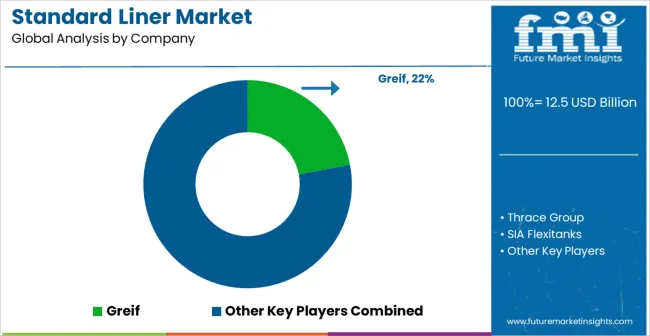
| Item | Value |
|---|---|
| Quantitative Units | USD 12.5 Billion |
| Material Type | Plastic and Metal |
| Product Type | End Fill Bulk, Top Fill Bulk, Open Top Bulk, and Wide Access Bulk |
| Size | 40 Feet, 20 Feet, and 30 Feet |
| End Use | Chemical, Polymer Additives, Agrochemicals, Plastic Resin, Paints & Coating, Agriculture, Food & Beverages, Building & Construction, Pharmaceutical, Mining, and Others (Household, Personal Care, etc.) |
| Regions Covered | North America, Europe, Asia-Pacific, Latin America, Middle East & Africa |
| Country Covered | United States, Canada, Germany, France, United Kingdom, China, Japan, India, Brazil, South Africa |
| Key Companies Profiled | Greif, Thrace Group, SIA Flexitanks, Nissei, Amcor, Berry Global, United Bags, Display Pack, CDF Corp, and Bulk Corp International |
The global standard liner market is estimated to be valued at USD 12.5 billion in 2025.
The market size for the standard liner market is projected to reach USD 22.0 billion by 2035.
The standard liner market is expected to grow at a 5.8% CAGR between 2025 and 2035.
The key product types in standard liner market are plastic, _polypropylene (pp), _polyethylene (pe), _high density polyethylene (hdpe), _low density polyethylene (ldpe), _polyvinyl chloride (pvc), _others, metal, _aluminium, _steel and _tin.
In terms of product type, end fill bulk segment to command 40.0% share in the standard liner market in 2025.






Our Research Products

The "Full Research Suite" delivers actionable market intel, deep dives on markets or technologies, so clients act faster, cut risk, and unlock growth.

The Leaderboard benchmarks and ranks top vendors, classifying them as Established Leaders, Leading Challengers, or Disruptors & Challengers.

Locates where complements amplify value and substitutes erode it, forecasting net impact by horizon

We deliver granular, decision-grade intel: market sizing, 5-year forecasts, pricing, adoption, usage, revenue, and operational KPIs—plus competitor tracking, regulation, and value chains—across 60 countries broadly.

Spot the shifts before they hit your P&L. We track inflection points, adoption curves, pricing moves, and ecosystem plays to show where demand is heading, why it is changing, and what to do next across high-growth markets and disruptive tech

Real-time reads of user behavior. We track shifting priorities, perceptions of today’s and next-gen services, and provider experience, then pace how fast tech moves from trial to adoption, blending buyer, consumer, and channel inputs with social signals (#WhySwitch, #UX).

Partner with our analyst team to build a custom report designed around your business priorities. From analysing market trends to assessing competitors or crafting bespoke datasets, we tailor insights to your needs.
Supplier Intelligence
Discovery & Profiling
Capacity & Footprint
Performance & Risk
Compliance & Governance
Commercial Readiness
Who Supplies Whom
Scorecards & Shortlists
Playbooks & Docs
Category Intelligence
Definition & Scope
Demand & Use Cases
Cost Drivers
Market Structure
Supply Chain Map
Trade & Policy
Operating Norms
Deliverables
Buyer Intelligence
Account Basics
Spend & Scope
Procurement Model
Vendor Requirements
Terms & Policies
Entry Strategy
Pain Points & Triggers
Outputs
Pricing Analysis
Benchmarks
Trends
Should-Cost
Indexation
Landed Cost
Commercial Terms
Deliverables
Brand Analysis
Positioning & Value Prop
Share & Presence
Customer Evidence
Go-to-Market
Digital & Reputation
Compliance & Trust
KPIs & Gaps
Outputs
Full Research Suite comprises of:
Market outlook & trends analysis
Interviews & case studies
Strategic recommendations
Vendor profiles & capabilities analysis
5-year forecasts
8 regions and 60+ country-level data splits
Market segment data splits
12 months of continuous data updates
DELIVERED AS:
PDF EXCEL ONLINE
Standard V Belts Market Size and Share Forecast Outlook 2025 to 2035
Linerless Label Market Size and Share Forecast Outlook 2025 to 2035
Standard High Precision Power Analyzers Market Size and Share Forecast Outlook 2025 to 2035
Linerless Closures Market Size and Share Forecast Outlook 2025 to 2035
Market Positioning & Share in Linerless Label Industry
Liner Bag Market Report – Key Trends & Forecast 2024-2034
Liner Hanger Market
LC Standard Adapters Market Size and Share Forecast Outlook 2025 to 2035
Eyeliner and Kajal Sculpting Pencil Packaging Market Trends and Forecast 2025 to 2035
Evaluating Eyeliner and Kajal Sculpting Pencil Packaging Market Share & Provider Insights
Eyeliner Pen Market
Cap Liner Market Size and Share Forecast Outlook 2025 to 2035
Box Liners Market Size and Share Forecast Outlook 2025 to 2035
IBC Liner Market Size and Share Forecast Outlook 2025 to 2035
Pan Liner Market Insights – Demand, Growth & Industry Trends 2025-2035
EPE Liner Market Analysis – Size, Growth & Demand 2025 to 2035
Examining Market Share Trends in the Cap Liner Industry
IBC Liner Market Share Insights & Industry Leaders
Industry Share Analysis for Box Liners Companies
Cap Liner Films Market

Thank you!
You will receive an email from our Business Development Manager. Please be sure to check your SPAM/JUNK folder too.
Chat With
MaRIA